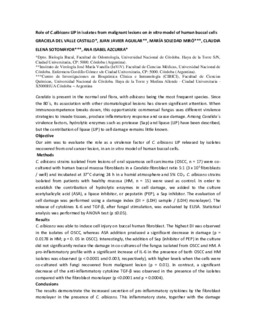| dc.contributor.author | Castillo, Graciela del Valle | |
| dc.contributor.author | Aguilar, Jonathan Damián | |
| dc.contributor.author | Miró, María Soledad | |
| dc.contributor.author | Sotomayor, Claudia | |
| dc.contributor.author | Azcurra, Ana Isabel | |
| dc.date.accessioned | 2022-10-19T14:38:54Z | |
| dc.date.available | 2022-10-19T14:38:54Z | |
| dc.date.issued | 2017 | |
| dc.identifier.uri | http://hdl.handle.net/11086/29026 | |
| dc.description.abstract | Candida is present in the normal oral flora, with albicans being the most frequent species. Since the 80´s, its association with other stomatological lesions has drawn significant attention. When immunocompetence breaks down, this opportunistic commensal fungus uses different virulence strategies to invade tissues, produce inflammatory response and cause damage. Among Candida´s virulence factors, hydrolytic enzymes such as protease (Sap) and lipase (LIP) have been described, but the contribution of lipase (LIP) to cell damage remains little known.ObjectiveOur aim was to evaluate the role as a virulence factor of C. albicans LIP released by isolates recovered from oral cancer lesion, in an in vitro model of human buccal cells. MethodsC. albicans strains isolated from lesions of oral squamous cell carcinoma (OSCC, n = 17) were co-cultured with human buccal mucosa fibroblasts in a Candida:fibroblast ratio 5:1 (3 x 105 fibroblasts / well) and incubated at 37°C during 24 h in a humid atmosphere and 5% CO2. C. albicans strains isolated from patients with healthy mucosa (HM, n = 15) were used as control. In order to establish the contribution of hydrolytic enzymes in cell damage, we added to the culture acetylsalicylic acid (ASA), a lipase inhibitor, or pepstatin (PEP), a Sap inhibitor. The evaluation of cell damage was performed using a damage index (DI = (LDH) sample / (LDH) monolayer). The release of cytokines IL-6 and TGF-β, after fungal stimulation, was evaluated by ELISA. Statistical analysis was performed by ANOVA test (p ≤0.05).ResultsC. albicans was able to induce cell injury on buccal human fibroblast. The highest DI was observed in the isolates of OSCC, whereas ASA addition produced a significant decrease in damage (p = 0.0178 in HM; p = 0. 05 in OSCC). Interestingly, the addition of Sap (inhibitor of PEP) in the culture did not significantly reduce the damage in co-cultures of the fungus isolated from OSCC and HM. A pro-inflammatory profile with a significant increase of IL-6 in the presence of both OSCC and HM isolates was observed (p < 0.0001 and 0.003, respectively), with higher levels when the cells were co-cultured with fungi recovered from malignant lesion (p = 0.01). In contrast, a significant decrease of the anti-inflammatory cytokine TGF-β was observed in the presence of the isolates compared with the fibroblast monolayer (p <0.0001 and p = 0.0004). ConclusionsThe results demonstrate the increased secretion of pro-inflammatory cytokines by the fibroblast monolayer in the presence of C. albicans. This inflammatory state, together with the damage observed and their decrease in the presence of ASA, could demonstrate the role of lipase in fungal virulence and its association with oral malignant lesions. These evidences reinforce the need for control of this commensal fungus when it overinfects lesions, suggesting its relevant role as a promoter of carcinogenesis. | es |
| dc.format.medium | Impreso | |
| dc.language.iso | eng | es |
| dc.rights | Attribution-NonCommercial-ShareAlike 4.0 International | * |
| dc.rights.uri | http://creativecommons.org/licenses/by-nc-sa/4.0/ | * |
| dc.subject | Candida albicans | es |
| dc.subject | Lipase | es |
| dc.subject | Tooth Injuries | es |
| dc.title | Role of C.albicans LIP in isolates from malignant lesions on in vitro model of human buccal cells | es |
| dc.type | conferenceObject | es |
| dc.description.fil | Fil: Castillo, Graciela del Valle. Universidad Nacional de Córdoba. Facultad de Odontología. Cátedra Química Biológica B; Argentina. | es |
| dc.description.fil | Fil: Aguilar, Jonathan Damian. Universidad Nacional de Córdoba. Facultad de Odontología; Argentina. | es |
| dc.description.fil | Fil: Miró, María Soledad. Universidad Nacional de Córdoba. Facultad de Ciencias Químicas. Departamento de Fisicoquímica; Argentina. | es |
| dc.description.fil | Fil: Sotomayor, Claudia. Consejo Nacional de Investigaciones Científicas y Técnicass. Centro de Investigaciones en Bioquímica Clínica e Inmunología; Argentina. | es |
| dc.description.fil | Fil: Azcurra, Ana Isabel. Universidad Nacional de Córdoba. Facultad de Odontología. Cátedra de Biología Celular B; Argentina. | es |
| dc.description.field | Otras Ciencias de la Salud | |
| dc.conference.city | Curitiba | |
| dc.conference.country | Brasil | |
| dc.conference.editorial | 15th INFOCUS 2017 | |
| dc.conference.event | 15th INFOCUS 2017 | |
| dc.conference.eventcountry | Brasil | |
| dc.conference.eventdate | 2017-11 | |
| dc.conference.journal | 15th INFOCUS 2017 | |
| dc.conference.publication | Libro | |
| dc.conference.work | Resumen | |
| dc.conference.type | Congreso | |





